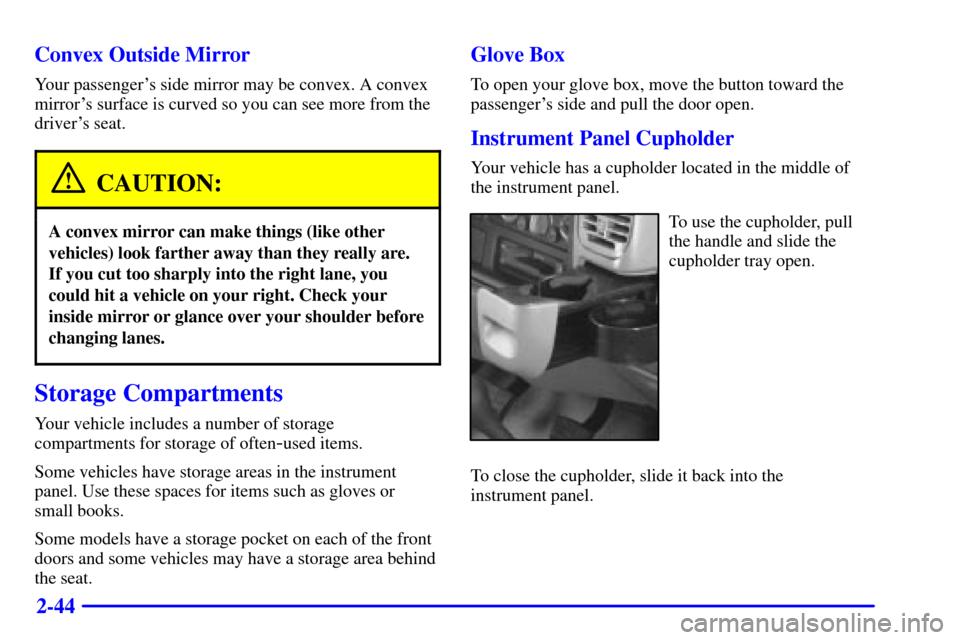Page 44 of 331

2-
2-1
Section 2 Features and Controls
Here you can learn about the many standard and optional features on your vehicle, and information on starting,
shifting and braking. Also explained are the instrument panel and the warning systems that tell you if everything is
working properly
-- and what to do if you have a problem.
2
-2 Windows
2
-4 Keys
2
-6 Door Locks
2
-7 Keyless Entry System (If Equipped)
2
-10 Theft
2
-11 Passlock�
2-12 New Vehicle ªBreak-Inº
2
-12 Ignition Positions
2
-14 Starting Your Gasoline Engine
2
-16 Engine Coolant Heater (If Equipped)
2
-17 Automatic Transmission Operation
2
-21 Manual Transmission Operation
2
-23 Parking Brake
2
-24 Shifting Into PARK (P)
(Automatic Transmission Only)
2
-27 Shifting Out of PARK (P)
(Automatic Transmission Only)2
-27 Parking Your Vehicle
(Manual Transmission Models Only)
2
-28 Parking Over Things That Burn
2
-28 Engine Exhaust
2
-29 Running Your Engine While You're Parked
(Automatic Transmission)
2
-30 Tilt Wheel (If Equipped)
2
-30 Turn Signal/Multifunction Lever
2
-37 Exterior Lamps
2
-39 Interior Lamps
2
-41 Mirrors
2
-44 Storage Compartments
2
-48 Instrument Panel - Your Information System
2
-50 Instrument Panel Cluster
2
-52 Warning Lights, Gages and Indicators
Page 84 of 331
2-41
Mirrors
Inside Day/Night Rearview Mirror
Push the tab under the mirror rearward to reduce glare
from headlamps behind you after dark. Pull the tab
forward for normal daytime operation.
Outside Manual Adjust Mirrors
Adjust your outside mirrors so you can see a little of the
side of your vehicle and have a clear view of any objects
behind you. Some mirrors can be folded in, to enter
narrow doorways.
The use of hood
-mounted air deflectors and add-on
convex mirror attachments may adversely affect mirror
performance.
Page 85 of 331
2-42 Camper-Type Outside Mirrors
(If Equipped)
If your vehicle is equipped with the camper-type
mirrors, they can be adjusted so that you can have a
clear view of any objects that may be beside or
behind you.
1. To adjust the mirrors when hauling a slide-in camper
or towing a trailer, turn the mirror by pushing the
mirror head toward the front of the vehicle.
Page 86 of 331
2-43
2. Turn the mirror head, so that the mirror surface faces
the rear of the vehicle.
West Coast-Type Outside Mirrors
(If Equipped)
If your vehicle is equipped with the west coast-type
mirrors, they can be adjusted so that you can have
a clear view of any objects that may be beside or
behind you.
A. Outer Mirror Frame
B. Mirror Head
C. Nut
The mirrors can be adjusted by turning the mirror
head (B) and moving the outer mirror frame (A)
backward or forward. You can also loosen the nut (C)
on the top and bottom of the outer mirror frame to tilt
the mirror head.
Page 87 of 331

2-44 Convex Outside Mirror
Your passenger's side mirror may be convex. A convex
mirror's surface is curved so you can see more from the
driver's seat.
CAUTION:
A convex mirror can make things (like other
vehicles) look farther away than they really are.
If you cut too sharply into the right lane, you
could hit a vehicle on your right. Check your
inside mirror or glance over your shoulder before
changing lanes.
Storage Compartments
Your vehicle includes a number of storage
compartments for storage of often
-used items.
Some vehicles have storage areas in the instrument
panel. Use these spaces for items such as gloves or
small books.
Some models have a storage pocket on each of the front
doors and some vehicles may have a storage area behind
the seat.
Glove Box
To open your glove box, move the button toward the
passenger's side and pull the door open.
Instrument Panel Cupholder
Your vehicle has a cupholder located in the middle of
the instrument panel.
To use the cupholder, pull
the handle and slide the
cupholder tray open.
To close the cupholder, slide it back into the
instrument panel.
Page 90 of 331
2-47
When adding electrical equipment, be sure to follow
the proper installation instructions included with the
equipment.
NOTICE:
Power outlets are designed for accessory plugs
only. Do not hang any type of accessory bracket
from the plug. Improper use of the power outlet
can cause damage not covered by your warranty.
Sun Visors
To block out glare, you can swing down the visors. You
can also swing them out to help block glare at the front
and side windows.
Some visors have an extender on the inside edge. When
the visor is down, pull the extender out for extra glare
coverage at the front or side.
Some visors have mirrors with lamps. If the mirror has
lamps, they will come on when you lift the mirror cover.
Page 145 of 331

4-13
�Check your mirrors, glance over your shoulder and
start your left lane change signal before moving out
of the right lane to pass. When you are far enough
ahead of the passed vehicle to see its front in your
inside mirror, activate your right lane change signal
and move back into the right lane. (Remember that
if your right outside mirror is convex, the vehicle
you just passed may seem to be farther away from
you than it really is.)
�Try not to pass more than one vehicle at a time
on two
-lane roads. Reconsider before passing the
next vehicle.
�Don't overtake a slowly moving vehicle too rapidly.
Even though the brake lamps are not flashing,
it may be slowing down or starting to turn.
�If you're being passed, make it easy for the following
driver to get ahead of you. Perhaps you can ease a
little to the right.
Loss of Control
Let's review what driving experts say about what happens
when the three control systems (brakes, steering and
acceleration) don't have enough friction where the tires
meet the road to do what the driver has asked.
In any emergency, don't give up. Keep trying to
steer and constantly seek an escape route or area of
less danger.
Skidding
In a skid, a driver can lose control of the vehicle.
Defensive drivers avoid most skids by taking
reasonable care suited to existing conditions, and
by not ªoverdrivingº those conditions. But skids
are always possible.
The three types of skids correspond to your vehicle's
three control systems. In the braking skid, your wheels
aren't rolling. In the steering or cornering skid, too
much speed or steering in a curve causes tires to slip
and lose cornering force. And in the acceleration skid,
too much throttle causes the driving wheels to spin.
A cornering skid and an acceleration skid are best
handled by easing your foot off the accelerator pedal.
Page 146 of 331

4-14
If your vehicle starts to slide, ease your foot off the
accelerator pedal and quickly steer the way you want
the vehicle to go. If you start steering quickly enough,
your vehicle may straighten out. Always be ready for a
second skid if it occurs.
Of course, traction is reduced when water, snow, ice,
gravel or other material is on the road. For safety,
you'll want to slow down and adjust your driving to
these conditions. It is important to slow down on
slippery surfaces because stopping distance will be
longer and vehicle control more limited.
While driving on a surface with reduced traction,
try your best to avoid sudden steering, acceleration
or braking (including engine braking by shifting to a
lower gear). Any sudden changes could cause the tires
to slide. You may not realize the surface is slippery until
your vehicle is skidding. Learn to recognize warning
clues
-- such as enough water, ice or packed snow on
the road to make a ªmirrored surfaceº
-- and slow down
when you have any doubt.
Remember: Any anti
-lock brake system (ABS) helps
avoid only the braking skid.
Driving at Night
Night driving is more dangerous than day driving.
One reason is that some drivers are likely to be
impaired
-- by alcohol or drugs, with night vision
problems, or by fatigue.